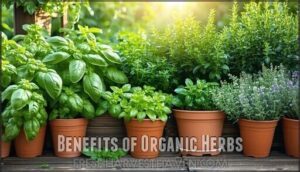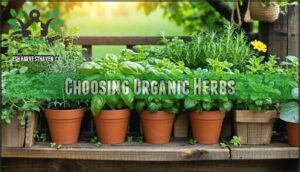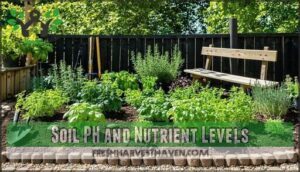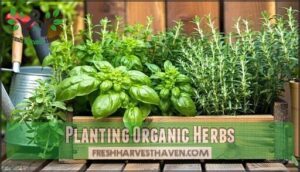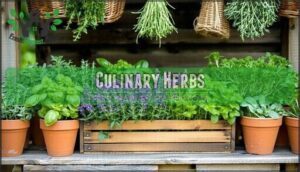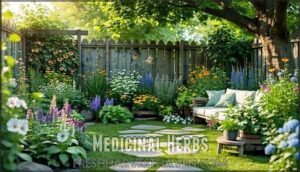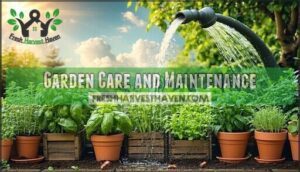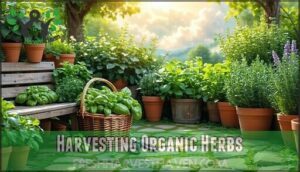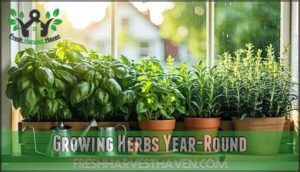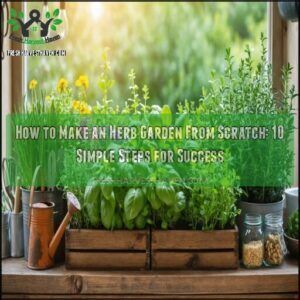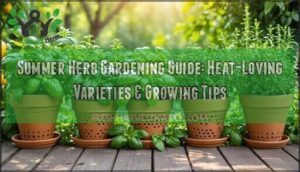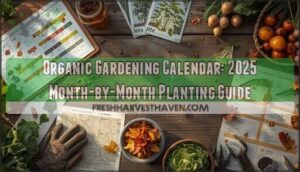This site is supported by our readers. We may earn a commission, at no cost to you, if you purchase through links.
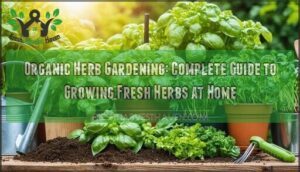
Start by choosing herbs that match your space and climate—basil thrives in warmth while parsley tolerates cooler conditions.
Use organic potting mix in containers or prepare garden beds with compost-enriched soil.
Most herbs need 6-8 hours of sunlight and well-draining soil to prevent root rot.
Plant seeds directly or start cuttings for faster results.
Water consistently but avoid soggy conditions, as herbs prefer slightly dry soil between waterings.
The secret lies in understanding each herb’s unique requirements and timing your harvest correctly.
Table Of Contents
- Key Takeaways
- Benefits of Organic Herbs
- Choosing Organic Herbs
- Preparing The Garden
- Planting Organic Herbs
- Herb Selection Guide
- Garden Care and Maintenance
- Harvesting Organic Herbs
- Container Gardening Tips
- Growing Herbs Year-Round
- Frequently Asked Questions (FAQs)
- How to grow herbs organically?
- What herbs cannot be planted next to each other?
- What is the healthiest herb to grow?
- Do herbs need to be organic?
- What common mistakes kill herbs most often?
- How do you know when herbs need water?
- Which herbs shouldnt be planted together?
- Can you grow herbs without any sunlight?
- Whats the best time to plant herb seeds?
- Conclusion
Key Takeaways
- You’ll achieve superior flavor and nutrition by growing herbs organically at home, as fresh herbs contain 40% more essential oils than store-bought varieties while eliminating pesticide exposure.
- You can start your organic herb garden with beginner-friendly varieties like basil, parsley, and mint that tolerate mistakes and adapt well to different growing conditions.
- You’ll need to provide 6-8 hours of daily sunlight and well-draining soil with proper spacing between plants to prevent fungal diseases and ensure healthy growth.
- You can extend your growing season year-round through container gardening, succession planting, and overwintering techniques like cold frames or bringing plants indoors.
Benefits of Organic Herbs
You’ll discover that growing organic herbs at home delivers superior flavor and nutritional value compared to store-bought alternatives.
These homegrown powerhouses pack more vitamins, antioxidants, and essential oils while reducing your environmental footprint and grocery bills, making them a great way to improve your health and reduce your environmental footprint.
Freshness and Flavor
Nothing beats the pure intensity of flavors you’ll discover when harvesting organic herbs straight from your garden.
Fresh herbs from your garden deliver flavor intensity that transforms every dish into something extraordinary.
Fresh-cut herbs deliver maximum potency and complexity that store-bought versions simply can’t match.
Key freshness advantages include:
- Harvest Timing – Pick herbs in late morning after dew evaporates for peak aroma retention
- Flavor Profiles – Homegrown organic herbs contain higher concentrations of volatile oils that create bold, nuanced tastes
- Culinary Uses – Fresh herb flavors transform ordinary dishes into restaurant-quality meals with minimal effort.
Your taste buds will thank you for this upgrade.
Rich in Vitamins and Antioxidants
Beyond great taste, organic herbs pack serious nutritional punch.
You’ll get higher vitamin content and antioxidant properties compared to store-bought alternatives.
These powerhouse plants contain concentrated phytonutrients that support your immune system and overall health.
The nutrient value stays intact when you harvest fresh, giving you maximum health benefits from nature’s own herbal remedies.
Environmental Benefits
When you grow organic herbs, you’re championing environmental sustainability by eliminating synthetic pesticides and fertilizers that harm soil and waterways.
Your carbon footprint shrinks dramatically since you’re not relying on commercial farming’s heavy machinery or long-distance transportation.
These eco-friendly practices support green living while organic methods naturally enhance biodiversity in your backyard ecosystem.
Economic Savings
Your wallet’s best friend lives in your backyard herb garden.
Fresh herbs at grocery stores cost $2-4 per small package, while a single plant produces months of harvests.
Consider these organic herb gardening cost savings:
- Initial investment of $20-30 yields $200+ worth of fresh herbs annually
- Seeds cost pennies compared to store-bought alternatives
- Perennial herbs like rosemary provide years of financial benefits
This frugal gardening approach transforms your budget planning while delivering superior flavor and nutrition.
Choosing Organic Herbs
Selecting the right herbs depends on your local climate, available space, and how you plan to use them in cooking or for health benefits.
Start with beginner-friendly varieties like basil, parsley, and mint that adapt well to different conditions and forgive early gardening mistakes, making them ideal for those new to herbs.
Climate and Space Considerations
Your climate zone dictates which herbs you can grow year-round versus seasonally.
Most herbs need 6-8 hours of direct sunlight daily, so map your garden’s sunlight patterns throughout the day.
Space optimization becomes essential in small areas – consider vertical gardening, container systems, and microclimate management near heat-retaining walls or sheltered spots for maximum garden space efficiency.
Personal Preference and Usage
Your culinary preferences shape herb selection more than any gardening rule book.
Think about the dishes you love most—Italian cuisine calls for basil and oregano, while Mexican cooking demands cilantro and fresh jalapeños.
Consider these flavor enhancement strategies:
- Aromatic Preferences – Choose herbs that match your scent favorites
- Dietary Needs – Select herbs that complement your nutritional goals
- Cooking Incorporation – Pick varieties you’ll actually use regularly
- Herb Pairing – Plan combinations that work together in recipes
- Herb Utilization – Consider both fresh and dried applications
Personal preferences drive successful herb gardens.
Beginner-Friendly Herbs
Starting with easy-to-grow varieties guarantees your herb gardening 101 journey succeeds from day one.
These beginner-friendly herbs tolerate mistakes while delivering impressive harvests for new gardeners.
| Herb | Why Perfect for Beginners | Key Growing Tip |
|---|---|---|
| Basil | Fast growth, clear watering needs | Pinch flowers for continued basil care |
| Mint | Nearly indestructible, spreads quickly | Container planting prevents aggressive mint growth |
| Parsley | Hardy, forgiving of neglect | Cut outer stems first for ongoing parsley tips |
Choose organic herb seeds for these reliable starters.
Focus your herb selection on varieties matching your cooking style – thyme usage works wonderfully in Mediterranean dishes, while growing organic herbs like cilantro suits Mexican cuisine perfectly.
Preparing The Garden
Before you plant your organic herbs, you’ll need to create the ideal growing environment through proper garden preparation.
This foundation stage determines whether your herbs will thrive or merely survive in their new home.
Optimal Sunlight and Spacing
Most herbs demand 6-8 sunlight hours daily for peak performance, though you’ll want to map your garden’s light patterns throughout the day first.
Strategic Garden Layout prevents taller plants from casting shadows on shorter specimens, while proper Plant Spacing guarantees robust Air Circulation that naturally deters fungal diseases.
Consider these sunlight requirements and herb garden spacing essentials:
- Position sun-loving herbs like rosemary and thyme in southern exposures
- Allow 12-18 inches between plants for adequate air movement
- Place taller herbs on the north side to avoid shading companions
- Create microclimates using heat-retaining walls or wind barriers
- Create easy access paths for watering herbs and maintenance tasks
Your herb garden sunlight access directly impacts essential oil production—those aromatic compounds that make homegrown herbs superior to store-bought varieties. Without sufficient light, you’ll get leggy plants with diluted flavors. For areas with limited natural light, using indoor grow lights can help supplement the needed sunlight hours.
Soil PH and Nutrient Levels
Beyond simply tossing seeds into dirt, successful herb gardening demands understanding your soil’s chemistry.
Soil Testing reveals pH levels and nutrient balance, forming your cultivation foundation.
Most herbs thrive between pH 6.0-7.5, where nutrients remain accessible.
Acidic soils lock away calcium and magnesium, while alkaline conditions bind iron and zinc.
You’ll need pH meters or test kits to monitor these levels accurately.
Compost Usage improves nutrient retention and buffers pH swings naturally.
When soil amendments are necessary, lime raises pH while sulfur lowers it.
Organic matter like compost enhances Nutrient Levels without disrupting beneficial microbes.
Smart Fertilizer Options target specific deficiencies identified through testing, avoiding the over-fertilization trap that actually dilutes essential oils in your herbs.
Understanding soil pH levels is vital for creating an ideal environment for herb growth, which involves Soil Testing and maintaining the right pH levels.
Planting Organic Herbs
Now that you’ve prepared your garden space, you’re ready to plant your organic herbs using three proven methods.
Whether you choose direct seeding, indoor starting, or propagation through cuttings, each technique offers unique advantages for establishing a thriving herb garden, with complete concepts like these helping you get started.
Sowing Seeds Directly
Direct seeding works best for anise, cilantro, fennel, and dill since they don’t handle transplanting well.
You’ll want to sow these seeds directly into prepared soil once spring arrives and frost danger passes. Follow seed packet instructions for proper seed depth and spacing – typically twice the seed’s diameter deep.
Good soil prep and consistent moisture boost germination rates substantially. Understanding herb seed varieties is essential for selecting the right herbs to grow in your garden.
Starting Seeds Indoors
Several months before your last frost date, you’ll want to master the art of seed starting indoors.
This indoor approach gives you a head start on the growing season.
- Seed Selection: Choose high-quality organic seeds for herbs like basil, oregano, and parsley
- Indoor Lighting: Position seedlings near south-facing windows or use grow lights for 12-16 hours daily
- Soil Temperature: Maintain 65-75°F for ideal germination using heating mats if needed
Starting small with indoor seed starting transforms your herb propagation methods into a year-round adventure.
Propagating Through Cuttings
While starting seeds indoors offers controlled conditions, propagating through cuttings provides faster results for certain herbs.
This method works exceptionally well for lavender, sage, lemon balm, and rosemary.
| Cutting Techniques | Best Herbs |
|---|---|
| Softwood cuttings | Lavender, lemon balm |
| Semi-hardwood cuttings | Rosemary, sage |
| Node planting method | All cutting varieties |
Select healthy stems with visible nodes for ideal root development.
Remove lower leaves, dip in rooting hormone, and plant in well-draining soil.
This herb propagation method bypasses lengthy germination periods.
Understanding root growth techniques is vital for successful herb cutting propagation.
Herb Selection Guide
Choosing the right herbs for your organic garden starts with understanding your climate, available space, and intended uses.
You’ll want to select a mix of culinary favorites like basil and rosemary alongside medicinal powerhouses such as chamomile and lavender to maximize your garden’s potential.
Culinary Herbs
When choosing culinary herbs for your organic garden, focus on varieties that’ll transform your cooking game.
Basil delivers sweet, peppery flavor profiles perfect for Italian dishes and pesto.
Rosemary’s woody essence enhances roasted meats, while thyme offers earthy notes for herb pairing with Mediterranean recipes.
Parsley and cilantro provide fresh brightness for meal planning across diverse cooking techniques.
These organic herbs support versatile recipe development.
Medicinal Herbs
Medicinal herb cultivation opens doors to botanical medicine and natural cures right in your backyard.
These therapeutic powerhouses contain bioactive compounds that support wellness through herbalism and aromatic therapy.
Popular medicinal herbs for organic herb gardening include:
- Echinacea – Reduces cold symptom severity and duration
- Sage – Decreases menopausal hot flashes within 8 weeks
- Lemon balm – Provides antibacterial and anti-anxiety benefits
- Feverfew – Prevents migraines but requires careful dosing
You’ll discover herbal remedies that complement modern healthcare while enjoying fresh herb cultivation.
Many herbs offer natural health benefits that can enhance your wellness journey.
Companion Planting
Strategic companion planting transforms your herb garden into a pest-fighting powerhouse.
Marigolds planted alongside basil create natural repellents that protect against aphids and whiteflies. Chives near roses improve soil health while deterring harmful insects.
Smart herb combinations like rosemary with sage enhance garden diversity and support beneficial pollinators. Proper plant spacing prevents overcrowding while maximizing these protective partnerships.
This organic gardening approach reduces pesticide needs through intelligent herb garden design. By understanding the benefits of companion planting herbs, gardeners can create thriving and resilient herb gardens.
Garden Care and Maintenance
Once you’ve successfully planted your herbs, proper care becomes essential for maximizing their growth potential and ensuring continuous harvests throughout the growing season.
The three key areas you’ll need to master are watering techniques that promote healthy root development, natural pest management strategies, and maintaining ideal soil conditions for long-term garden productivity.
Watering and Fertilizing
Your herbs’ watering schedule demands precision—think of it as their daily coffee ritual.
Looking at the paragraph about watering schedules and the request for a short blockquote in the same tone, here’s an engaging quote:
Think of pruning as your herbs’ weekly spa appointment—they’ll reward you with lusher growth.
Most herbs prefer deep, infrequent watering that encourages robust root development. Check soil moisture regularly by inserting your finger two inches deep into the earth.
- Water Scheduling: Early morning irrigation prevents fungal diseases
- Soil Moisture: Maintain consistent dampness without waterlogging
- Organic Fertilizers: Apply diluted compost tea monthly during growing season
- Irrigation Methods: Use drip systems or soaker hoses for efficient delivery
Pest Control and Pruning
Managing pests and proper pruning techniques keep your herb garden thriving.
Natural pest control methods like handpicking insects and organic sprays work effectively without harming beneficial insects. Spinosad-based products reduce infestations by 74%, while companion planting with marigolds naturally repels pests.
For pruning tips, cut at 45-degree angles above nodes using clean, sharp tools. Remove no more than 25% of plant tissue per season to prevent stress and promote healthy regrowth. Proper pruning and natural pest control methods, including companion planting, are essential for a thriving herb garden.
Soil Health and Drainage
Healthy soil forms the foundation of thriving herb gardens, making proper soil preparation essential for success.
Regular soil testing reveals pH levels and nutrient deficiencies, while organic soil amendments like compost boost soil quality naturally.
- Test soil pH annually – Most herbs prefer neutral conditions between 6.0-7.0
- Add organic matter regularly – Compost usage improves structure and fertility
- Install proper drainage systems – Raised beds or French drains prevent waterlogging
- Mulch around plants – Retains moisture while suppressing weeds
- Monitor soil health indicators – Check for earthworms and crumbly texture
Good herb garden drainage prevents root rot and disease.
Harvesting Organic Herbs
You’ll know when your herbs reach peak potency by harvesting them at the right time—most herbs taste best when picked just before they flower.
Proper timing and technique guarantee you get maximum flavor and essential oils from your homegrown organic herbs, ensuring you achieve maximum flavor.
Timing and Technique
Perfect harvest timing transforms decent herbs into flavor powerhouses.
You’ll maximize essential oils by cutting herbs in late morning after dew evaporates but before afternoon heat peaks.
This sweet spot concentrates aromatic compounds that make your organic gardening efforts worthwhile.
Sharp, clean pruning techniques prevent disease while encouraging bushy regrowth for continuous harvests throughout the season, which is crucial for a successful and continuous harvest.
Preserving and Storing
When you bring in your harvest, don’t let it wilt on the countertop—preservation methods like drying herbs or freezing herbs lock in flavor and nutrients.
Try air-drying or using low heat for delicate leaves.
Herb oils and infusion techniques also extend shelf life.
For herb storage, use airtight containers away from sunlight. Smart storage tips keep your herbs potent, making every pinch count long after harvest.
Using Fresh Herbs
Fresh herbs release maximum flavor enhancement when used immediately after harvesting.
You’ll achieve prime herb pairing by combining complementary aromatics like basil with tomatoes or mint with lamb.
Organic herb gardening pays off in fresh recipes where peak volatile oils shine.
These culinary tips maximize aromatic uses: add delicate herbs last during cooking, while sturdy varieties like rosemary handle longer heat exposure perfectly.
Container Gardening Tips
Container gardening offers you complete control over your herbs’ growing conditions, making it perfect for small spaces or challenging climates.
You’ll need the right combination of proper containers, quality soil, and favorable placement to guarantee your herbs thrive in their portable environment.
Choosing The Right Pots
Selecting appropriate containers transforms your herb garden from struggle to success. Container choice dramatically impacts plant health and growth rates.
- Pot Materials: Terra cotta provides excellent breathability, while ceramic planters offer durability and aesthetic appeal
- Container Size: Most herbs need 6-12 inch diameter pots with adequate soil depth for root development
- Drainage Holes: Essential feature preventing waterlogged roots – drill additional holes if needed
Consider pot placement requirements when choosing herb planters for your container gardening setup or vertical garden planters. Using the right Terra Cotta options can greatly enhance herb garden performance.
Soil and Drainage Considerations
Container success hinges on proper soil composition and drainage systems.
Use a balanced mix: 33% composted soil, 33% coco coir for water retention, and 33% perlite for drainage.
Soil testing reveals pH levels—herbs prefer 6.0-7.5.
Well-drained soil prevents root rot, while organic matter enriches soil health.
Choose containers with drainage holes and avoid compacted soil types for ideal herb growth.
Optimal Sunlight and Temperature
Your herbs need six to eight sunlight hours daily for robust growth and ideal flavor development.
Position containers where they’ll receive direct sunlight during peak morning and afternoon periods.
Most culinary herbs demonstrate excellent heat tolerance, thriving in temperatures between 65-75°F.
Monitor sun exposure patterns throughout seasons, as shifting angles affect light spectrum availability.
Create shaded areas for delicate herbs like cilantro during intense summer heat, while heat-loving basil and rosemary flourish in full exposure to receive direct sunlight and enjoy ideal flavor.
Growing Herbs Year-Round
You can enjoy fresh herbs throughout the entire year with proper planning and indoor growing techniques. Strategic succession planting and seasonal adjustments guarantee continuous harvests regardless of outdoor weather conditions.
Overwintering Herbs Indoors
During winter’s harsh embrace, overwintering herbs indoors becomes essential for continuous harvests.
Choose frost-sensitive varieties like basil and tender perennials such as rosemary for Indoor Greenhouse setups.
Provide 5-6 hours of sunlight through south-facing windows or supplement with Indoor Lighting for 12-16 hours daily.
Maintain temperatures between 60-70°F while ensuring proper Winter Care through well-draining soil and reduced watering schedules for ideal Herb Protection.
To achieve prime growth, understanding temperature zones is vital for the health of your herbs, and is key to ideal Herb development.
Extending The Growing Season
You can stretch your harvest well beyond summer’s end with smart protection strategies.
Cold frames act as mini-greenhouses, trapping solar heat to shield herbs from frost.
Greenhouses offer premium crop protection for serious gardeners.
Row covers provide lightweight season extension for tender herbs like basil.
Even simple cloches made from plastic bottles can save your cilantro when temperatures drop unexpectedly, utilizing a basic form of greenhouse effect.
Succession Planting and Crop Rotation
Since maximizing your herb yield requires strategic timing, succession planting guarantees continuous harvests throughout the growing season.
Plant fast-growing herbs like cilantro and dill every two to three weeks for fresh supplies.
Crop rotation prevents soil depletion by rotating herb families annually, which is an essential part of this organic herb gardening approach.
This approach maintains soil health while optimizing plant scheduling and harvest timing for year-round abundance.
Frequently Asked Questions (FAQs)
How to grow herbs organically?
Studies show homegrown herbs contain 40% more essential oils than store-bought varieties. You’ll need well-draining soil, six hours of sunlight, and organic compost. Skip synthetic fertilizers—they dilute flavor compounds.
What herbs cannot be planted next to each other?
Avoid planting mint near parsley, as mint’s aggressive spreading can overtake slower-growing herbs. Don’t place fennel near most herbs since it inhibits their growth through natural compounds.
What is the healthiest herb to grow?
Mint stands out as the healthiest herb you can grow, packed with antioxidants, vitamins A and C, and digestive compounds.
It’s virtually foolproof to cultivate and provides powerful anti-inflammatory benefits for your body.
Do herbs need to be organic?
Herbs don’t require organic certification to be healthy, but you’ll maximize nutritional value and minimize chemical exposure by growing them organically without synthetic pesticides or fertilizers.
What common mistakes kill herbs most often?
Overwatering destroys most herbs by suffocating roots and promoting fungal diseases. You’re also likely killing them with poor drainage, insufficient sunlight, or cramped spacing that restricts airflow.
How do you know when herbs need water?
Like a thirsty plant whispering for relief, your herbs tell you they need water through clear visual cues.
Check the soil’s top inch—if it’s dry, it’s time.
Leaves may appear slightly wilted or less vibrant when thirsty.
Which herbs shouldnt be planted together?
You shouldn’t plant mint with other herbs since it’ll overtake everything, spreading aggressively through underground runners. Keep fennel separate too—it inhibits growth in most companions through allelopathic compounds.
Can you grow herbs without any sunlight?
While some herbs can tolerate partial shade, they all need some light to photosynthesize. You’d need grow lights indoors to successfully cultivate herbs in zero-sunlight conditions.
Whats the best time to plant herb seeds?
Start herb seeds indoors in late winter for transplanting after frost danger passes.
You’ll achieve better germination rates with consistent moisture and proper timing.
Conclusion
Mastering organic herb gardening transforms you from a grocery store dependent into a self-sufficient herb connoisseur with an arsenal of fresh flavors at your fingertips.
You’ve learned the essential techniques for successful cultivation, from soil preparation to harvest timing.
Your commitment to organic methods guarantees you’ll enjoy pesticide-free herbs while supporting beneficial insects and soil microorganisms.
With proper planning and consistent care, you’ll maintain a thriving herb garden that provides year-round culinary and medicinal benefits for your family.
- https://attra.ncat.org/publication/herbs-organic-greenhouse-production/
- https://www.statista.com/statistics/716566/us-herb-gardening-participation/
- https://www.mdpi.com/2076-3417/10/10/3468
- https://www.farmstandapp.com/62798/6-best-organic-herb-gardening-techniques/
- https://www.parkseed.com/blog/benefits-of-growing-an-herb-garden

